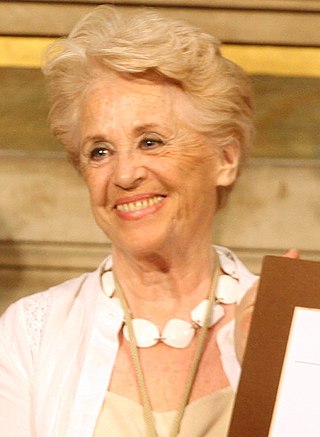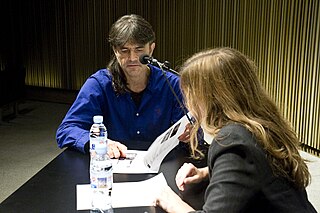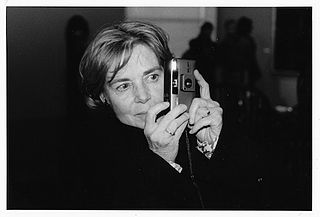Isabel Oliva | |
|---|---|
 | |
| Born | November 27, 1924 Girona, Catalonia, Spain |
| Language | Catalan |
Isabel Oliva Prat (born 27 November 1924, Girona) is a Spanish poet in the Catalan language. [1] [2]
Isabel Oliva | |
|---|---|
 | |
| Born | November 27, 1924 Girona, Catalonia, Spain |
| Language | Catalan |
Isabel Oliva Prat (born 27 November 1924, Girona) is a Spanish poet in the Catalan language. [1] [2]
Prat was born in Girona, and attended school there. Her father died shortly before the Spanish Civil War. [1]
Prat became a teacher after graduating from Escola Normal de Mestres. Her first position was in Espolla, where she met Francisco Torrado, whom she married in 1950. The couple had three children. After Torrado died, Prat returned to education, working as a Catalan language teacher in Font de la Pólvora. [1]
She studied Teaching and Music, and she worked as a teacher in several educational centers. Her father and uncle were music teachers and encouraged her from a young age to cultivate the art of music.
Prat was always a great fan of poetry, but did not begin to write and publish poetry of her own until after her retirement. [1]
Source [1]

Olga Xirinacs Díaz is a Spanish writer and piano teacher. During her literary career, she has written poetry, drama, tales and essays. She was born in Tarragona, where she still lives and works.

Montserrat Carulla i Ventura was a Spanish actress.

Josep Carner i Puigoriol, was a Spanish poet, journalist, playwright and translator. He was also known as the Prince of Catalan Poets. He was nominated for the Nobel Prize in Literature seven times.

Pere Jaume Borrell i Guinart, known as Perejaume, is a Spanish contemporary artist.

Isabel-Clara Simó i Monllor was a Spanish journalist and writer. She is considered one of the most important writers in the Catalan language.

J. N. Santaeulàlia, Josep Navarro Santaeulàlia is a Catalan writer and poet.

Albert Ràfols-Casamada was a Spanish painter, poet and art teacher involved in the vanguard movements of his time. He is considered one of the most important, multifaceted Catalan artists of his time. His artwork began in the post-expressionist, figurative sphere but soon developed into his own abstract style grounded in a poetic rendering of everyday reality.

Caterina Albert i Paradís, better known by her pen name Víctor Català, was a Catalan writer in Catalan and Spanish who participated in the Modernisme movement and was the author of one of the signature works of the genre, Solitud (Solitude) (1905). Her literary skill was first recognized in 1898, when she received the Jocs Florals prize; soon thereafter, she began using the pseudonym Victor Català, taking it from the protagonist of a novel she never finished. Despite her success as a dramatist and her forays into poetry, she is best known for her work in narrative literature, with the force of her style and the richness of her diction being especially noted. She died in her hometown of l’Escala, Catalonia, in 1966 and is interred in the Cementiri Vell de l’Escala.

Josep Maria Nadal i Farreras is Professor of History of Language at the University of Girona.

Aurora Bertrana i Salazar was a Catalan cellist and writer, notable for her exotic stories and novels. She lived in Tahiti, Morocco, Switzerland, and France. Bertrana's republished memoires combining Memòries fins al 1935 (1973) and Memòries del 1935 al retorn a Catalunya (1975) provide a detailed account of her life.

Cèlia Sànchez-Mústich is a Spanish poet and writer in the Catalan language. She has lived in Sitges since 2001.

Alexandre 'Àlex' Granell Nogué is a Spanish professional footballer who plays for Bolivian club Bolívar as a central midfielder.
Núria Albó i Corrons is a Spanish writer, teacher, and politician. She is a Creu de Sant Jordi and Premi Vila de'Arenys laureate.

Maria Carme Forcadell i Lluís is a Spanish politician from Catalonia. She is the former President of the Parliament of Catalonia, as well as a Catalan high school teacher, known for her Catalan independence activism.

Maria Mercè Roca i Perich is a Catalan writer and politician from Spain. She was deputy to the Parliament of Catalonia for Republican Left of Catalonia, and currently serves as a councillor at the City Council of Girona for the same party.

Maria Lluïsa Borràs i González, doctorate in Art History from the Universitat de Barcelona, was a Spanish writer, critic, exhibition curator and specialist in the avant-garde and Dadaism.

Teresa Pàmies Bertran was a Spanish Catalan-language writer.

Narcís Comadira i Moragriega is a Spanish poet, painter, playwright, translator, journalist and literary critic. His poetry is rather classical in nature, with a contemplative theme and a certain ironic point of view. As a painter, he understands his work as an extension of poetry. His first works show references to surrealism and pop culture, as well as his master Domènec Fita. In the late 70's he left the figurative painting to begin to represent nature and architecture, specializing in a very personal landscape and marked by realism, which in his latest work is leading to a synthesis of it, where fewer and fewer elements appear in his works.

Renada-Laura Portet was the pen name of Renada-Laura Calmon-Ouillet a Northern Catalonia writer and linguist of Occitania origin. She was one of the most important literary voices in Northern Catalonia. Portet cultivated the genres of poetry, short story, novel, drama, and essays, as well as scientific or research writing on topics such as linguistics, toponymy, or onomastics. She used several other pseudonyms including, "Caterina Martí", "Isabel Rosselló", "Vicenta Pallarès", "Toni Vidaló" and "Ramon Oliver".
Matilde Sabaté Grisó (1904–1940) was a Catalan anarcho-syndicalist, militiawoman and teacher. She was the second woman to be summarily court-martialled and shot in Girona and one of 17 women executed in Catalonia by Francoist Spain.